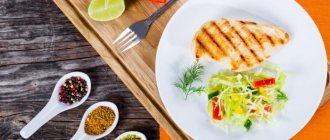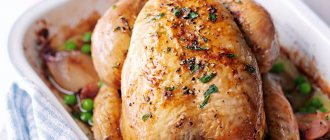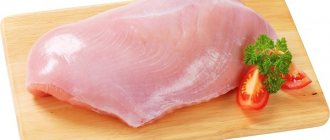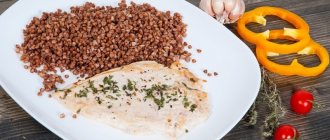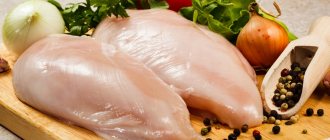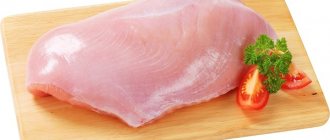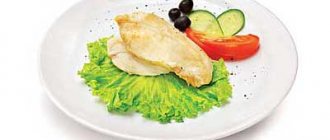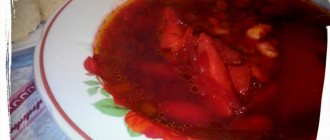Composition of chicken breasts
Chicken breasts are rich in easily digestible, well-balanced protein (20-30 g per 100 g of product), as well as valuable B vitamins:
- B3 (niacin) is involved in metabolic reactions, promotes the production of energy from carbohydrates, fats and proteins, and is part of cellular enzymes involved in respiration and metabolism.
- B4 (choline) is involved in the synthesis of acetylcholine, which transmits nerve impulses, regulates insulin levels, promotes the normal functioning of the liver, kidneys and hematopoietic organs.
- B6 (pyridoxine) is involved in the metabolism of proteins and fats. Contributes to the production of red blood cells that distribute oxygen. Necessary for the conversion of glycogen into glucose, for the normal functioning of the immune system and for the formation of nerve cells.
- B9 (folic acid) is essential for the functioning of the circulatory and immune systems.
White chicken meat contains vitamins A, C, H. Chicken breasts are an excellent source of selenium and phosphorus. They contain potassium, magnesium, sulfur, chromium, copper, fluorine, zinc. True, chicken meat is significantly inferior in iron content to beef and pork (1.5 mg versus 3 mg per 100 g of product).
Calories in chicken breasts. How many calories are in chicken breast, boiled, fried.
Calorie content of chicken breast (boiled, fried, baked) - table per 100 grams
- 1 Calorie content of chicken breast per 100 grams
- 2 Calorie content of chicken breast and dietary properties
- 3 Chicken breast: calorie content, composition, beneficial properties
- 4 Calorie content of chicken breast
- 5 Chicken breast: calorie content, composition, beneficial properties
Since the calorie content of chicken breast is insignificant, it can become a complete dinner for those who want to lose weight. Tender chicken meat goes well with almost all foods; it consists mostly of protein and is low in fat and carbohydrates. But first you need to figure out in what form it is best to prepare it. After all, as you know, the calorie content of fried and boiled dishes differs.
The breast is the most valuable part of a chicken carcass. This is a universal dietary product, dishes from which are included in the therapeutic diet. Due to its low fat content and therefore low energy value, breast fillet is allowed in many diets.
White chicken fillet meat contains choline, B vitamins, retinol, ascorbic and nicotinic acids, and niacin. These components regulate the functioning of the adrenal glands and gastrointestinal tract, and help cleanse the liver. Minerals are represented by potassium, magnesium, zinc, selenium, copper, iron, phosphorus, sodium. This set normalizes heart function, stimulates immune defense during ARVI epidemics and during rehabilitation after illnesses.
The calorie content of a chicken breast with skin is 135 kcal, without skin - 113.
For the energy value of the daily diet recommended for diets, a serving of cooked fillet will be about 5.5% of the total calories. In addition, 24% of the protein contained in white meat corresponds to only 2% fat, so its regular consumption stimulates the growth of muscle mass without adding fat.
The method of preparing food largely determines the energy value of the finished dish. Those who adhere to a healthy diet should boil skinless and boneless chicken breast. In this case, its calorie content reaches 137 kcal; such meat goes well with both cereals and vegetables.
Steamed breast has a minimum calorie content of 113 kcal.
It is not recommended to fry fillet, because chicken often turns out to be dry, and the energy value of the prepared dish increases sharply (~ 158 kcal). The calorie content of fried breast depends on the amount of vegetable oil used during cooking. It is recommended to grill the fillet; it contains fewer calories (~ 150 kcal).
A dietary option for preparing chicken is baking it in the oven. The meat can be marinated in spices and seasonings, add soy sauce and orange juice. Thanks to this, it will be soft and juicy, and the finished dish will become the main component of dinner. But it should be noted that additional ingredients increase the nutritional value of cooked meat.
The calorie content table per 100 g allows you to quickly find the product you need and calculate your daily calorie intake. Choose the option for preparing dietary chicken breast.
Chicken fillet is one of the lowest calorie meats. However, it contains a huge amount of vitamins and minerals, which is important for those who are on a diet and constantly limit themselves. The most beneficial for a healthy diet is skinless chicken breast, steamed or boiled. Read about the calorie content of other parts of chicken in our publication.
By selecting different ingredients with which to cook meat, you can create real culinary masterpieces every day. And monitoring the nutritional value of ready-made meals will allow you to gradually say goodbye to extra pounds.
| Property | Meaning |
| Calorie content, kcal | 113 |
| Proteins, g | 23,6 |
| Carbohydrates, g | 0,4 |
| Fats, gr | 1,9 |
Product calculator
Enter the quantity of the product “Chicken breast (fillet)” to calculate its nutritional value
| Property | Meaning | % of normal | |
| Calorie content, kcal | 113 | 5.65 | 5.65% |
| Proteins, g | 23,6 | 15.33 | 15.33% |
| Carbohydrates, g | 0,4 | 0 | 0% |
| Fats, gr | 1,9 | 2.27 | 2.27% |
Micro- and macroelements in Chicken breast (fillet)
Chicken breast (fillet) contains the following elements: Ash, Water, Sodium, Potassium, Phosphorus, Magnesium, Calcium, Sulfur, Copper, Iodine, Manganese, Chromium, Fluorine, Cobalt, Zinc, Iron, Chlorine.
| Micro and macro element | Meaning |
| Zola, Mr. | 1,1 |
| Water, city | 73 |
| Sodium, mg | 60 |
| Potassium, mg | 292 |
| Phosphorus, mg | 171 |
| Magnesium, mg | 86 |
| Calcium, mg | 8 |
| Sulfur, mg | 186 |
| Copper, µg | 76 |
| Iodine, mcg | 6 |
| Manganese, mg | 0,019 |
| Chromium, µg | 9 |
| Fluorine, mcg | 130 |
| Cobalt, µg | 12 |
| Zinc, mg | 2,055 |
| Iron, mg | 1,4 |
| Chlorine, mg | 77 |
Vitamins in Chicken breast (fillet)
Chicken breast (fillet) contains the following vitamins: Ash, Water, Sodium, Potassium, Phosphorus, Magnesium, Calcium, Sulfur, Copper, Iodine, Manganese, Chromium, Fluorine, Cobalt, Zinc, Iron, Chlorine.
| Vitamin | Meaning |
| Vitamin B1 (thiamine), mg | 0,07 |
| Vitamin B2 (riboflavin), mg | 0,07 |
| Vitamin B6 (pyridoxine), mg | 0,5 |
| Vitamin B9 (folic), mcg | 4,3 |
| Vitamin C, mg | 1,8 |
| Vitamin E (TE), mg | 0,2 |
| Vitamin PP (Niacin equivalent), mg | 10,7212 |
| Vitamin B12 (cobalamins), mcg | 0,6 |
| Choline, mg | 76 |
| Vitamin A (VE), mcg | 70 |
| Vitamin B5 (pantothenic), mg | 0,8 |
| Vitamin PP, mg | 10,9 |
| Vitamin H (biotin), mcg | 10 |
| Product | Kcal | Proteins, g | Fats, g | Angle, g |
| Fried Chicken Without Coating (Skin Eaten) | 260 | 28,62 | 15,35 | 0 |
| Fried Chicken Wing Without Coating (Skin Eaten) | 318 | 27,01 | 22,62 | 0 |
| Fried Chicken Leg Without Coating (Skin Eaten) | 250 | 27,31 | 14,78 | 0 |
| Fried or Baked Chicken | 237 | 27,07 | 13,49 | 0 |
| Fried or Baked Chicken (Skin Not Eaten) | 188 | 28,69 | 7,35 | 0 |
| or Baked Chicken Breast (Skin Not Eaten) | 164 | 30,76 | 3,54 | 0 |
| Chicken Meat (Roasting) | 111 | 20,33 | 2,7 | 0 |
| Chicken Meat and Skin (Roasting) | 216 | 17,14 | 15,85 | 0 |
| Minced Chicken | 237 | 27,07 | 13,49 | 0 |
| Breaded Chicken Cutlets, Fillet or Pieces | 297 | 15,59 | 18,82 | 16,32 |
| Breaded Chicken Cutlets with Cheese | 279 | 15,69 | 16,67 | 16,26 |
| Chicken breast | 195 | 29,55 | 7,72 | 0 |
| Chicken Breast (Skin Not Eaten) | 164 | 30,76 | 3,54 | 0 |
| Fried or Baked Chicken Breast | 195 | 29,55 | 7,72 | 0 |
| Chicken fillet | 110 | 23,09 | 1,24 | 0 |
| Chicken Thighs | 245 | 24,85 | 15,36 | 0 |
| Chicken Thighs (Skin Not Eaten) | 207 | 25,72 | 10,79 | 0 |
| Chicken thighs | 119 | 19,65 | 3,91 | 0 |
| Fried or Baked Chicken Thighs | 245 | 24,85 | 15,36 | 0 |
| Chicken Wing | 288 | 26,64 | 19,3 | 0 |
| Chicken Wing (Skin Not Eaten) | 201 | 30,21 | 8,06 | 0 |
| Chicken Wings with Skin | 222 | 18,33 | 15,97 | 0 |
| Chicken drumsticks | 214 | 26,8 | 11,06 | 0 |
| Chicken Drumsticks (Skin Not Eaten) | 171 | 28,05 | 5,61 | 0 |
| Fried or Baked Chicken Drumstick | 214 | 26,8 | 11,06 | 0 |
| Chicken Drumsticks with Skin | 161 | 19,27 | 8,68 | 0 |
| Chicken | 237 | 27,07 | 13,49 | 0 |
| Chicken (Skin Not Eaten) | 188 | 28,69 | 7,35 | 0 |
| Fried chicken | 237 | 27,07 | 13,49 | 0 |
| Fried Chicken (Skin Not Eaten) | 188 | 28,69 | 7,35 | 0 |
| Chicken Meatballs | 161 | 19,39 | 5,62 | 6,94 |
| Chick | 183 | 17,6 | 12,3 | 0,4 |
| Chicken legs | 184,6 | 21,3 | 11 | 0,1 |
| Chicken legs | 161 | 19,27 | 8,68 | 0 |
| Chicken wings | 222 | 18,33 | 15,97 | 0 |
| Smoked chicken | 184 | 27,48 | 8,18 | 0,02 |
| Smoked chicken breast | 184 | 27,48 | 8,18 | 0,02 |
| Smoked chicken legs | 233 | 22,93 | 15,7 | 0,02 |
| Smoked chicken wings | 290 | 26,86 | 19,46 | 0 |
| Chicken gherkins | 139,7 | 18,7 | 7 | 0,5 |
| Chicken nuggets | 285 | 14,97 | 18,07 | 15,67 |
| Canned chicken | 185 | 25,3 | 8,1 | 0,9 |
| Marinated chicken wings | 111,14 | 10,26 | 5,92 | 4,45 |
| Chicken beef stroganoff | 163 | 14,73 | 2 | 0,4 |
| Marinated chicken legs | 200 | 17 | 14 | 1,7 |
| Marinated chicken fillet | 241,97 | 14,97 | 17,5 | 5,13 |
| Chicken goulash | 163 | 14,73 | 2 | 0,4 |
| Chicken schnitzel | 188,6 | 27,032 | 6,224 | 5,694 |
| Broiler chickens | 220 | 18,7 | 16,1 | 0 |
| Chicken drumstick | 200,3 | 18,8 | 13,9 | 0 |
The benefits of chicken breast
Boiled chicken breast is very useful for problems with the gastrointestinal tract, including gastritis and ulcers, it promotes digestion and neutralizes excess acidity in the body. White chicken meat is also useful for problems with blood vessels, it helps prevent heart attacks and strokes, and the low calorie content of boiled chicken breast helps not to overload the body with excess calories. It is best to boil chicken in a saucepan, but the healthiest option is steamed chicken, which retains all the nutrients, has a beautiful appearance, and becomes very juicy and soft. Chicken breast is best consumed with vegetables to balance the simultaneous intake of protein and fiber in the body.
Chicken fillet is good for teeth, bone tissue and muscles; it contains the largest amount of zinc and phosphorus. Magnesium improves memory, restores nerve cells, relieves irritability, promotes wound healing, and B vitamins normalize blood sugar levels, which is why chicken breast is also recommended for elderly people.
Eating chicken breast has a positive effect on the body's metabolic processes, improves skin color, condition of nails and hair, and the selenium and lysine it contains have good antibacterial properties and strengthen the immune system, preventing colds.
Chicken is used to restore the strength of physically exhausted people and to strengthen the immune system. Meat is a preventive measure for stroke and myocardial infarction. B vitamins, which are contained in chicken meat, have a positive effect on metabolic processes in the body, on the functioning of the nervous system, and support healthy skin and nails. Chicken meat is useful for patients with peptic ulcers and gastritis, since the fibers of the meat will attract excess acidity, which irritates the mucous membranes of the internal organs.
High Protein Foods
How many calories are in boiled skinless chicken breast. Calorie content of boiled chicken breast
How many calories are in boiled skinless chicken breast. Calorie content of boiled chicken breast
Many people know that the calorie content of this product is low - 100 grams of boiled skinless chicken breast contains only 120 kcal. Meat with skin has a slightly higher calorie content. For people who have set themselves the goal of losing weight, frying chicken is not recommended, since the number of calories in this case increases sharply. But these are not all negative properties, because the load on the digestive system also increases. Finding out how many calories are in boiled chicken breast is quite simple if you look at the data in the table.
Calorie table for boiled chicken breast
| Product (100 grams) | Calorie content, kcal |
| Boiled chicken breast without skin | 120 |
| Boiled chicken breast with skin | 137 |
| Boiled chicken breast without skin, topped with creamy sauce | 135 |
| Boiled skinless chicken breast with apple salad | 168 |
Table of BZHU boiled chicken breast
On a note! To increase the amount of nutrients in chicken breast, you need to cook it in a certain way. First, the product must be washed. Then add water and bring to a boil. Drain the liquid, rinse the fillet again and cover with cold water. Add salt, skim off any foam that has formed on the surface of the broth, and cook over low heat until tender. This cooking method is suitable for store-bought meat. By draining the first water, you can get rid of most of the chemicals. If a homemade product is used, such manipulations are not necessary.
When fresh chicken is cooked, the weight of the meat decreases due to the removal of water. In this case, part of the calories goes into the broth.
How many calories are in boiled buckwheat in water? Calorie content of buckwheat per 100 grams
In 100 gr. raw buckwheat contains 313 kilos of calories. This is very little, which is why this food product is so actively added to diets. This water-based product is obtained from buckwheat grains by separating the shell and kernel. The quality of the kernel determines what grade of cereal will be - first, second or third.
Attention! Buckwheat contains proteins (12.7 g), fats (3.3 g) and carbohydrates (62.1 g).
The low calorie content of boiled buckwheat is compensated by a rich supply of minerals. There are almost 2 times more of them than in other types of cereals on water. This benefit when consumed helps improve metabolism. Buckwheat is predominantly composed of polyunsaturated fats due to its organic origin. Thanks to this, they have a positive effect on fat metabolism and help reduce blood cholesterol.
Calorie content of boiled buckwheat with salt on water
Cooking buckwheat this way is very simple, it is important to follow the proportions. But salt has a direct impact on the percentage of useful components in the finished dish. During cooking, the grains swell, absorb water and eventually increase in size by 3-4 times. Calorie content per 100 g. buckwheat boiled in water with salt is reduced to 110 kcal. And then the amount of proteins will decrease to 4 grams, fats to 1 gram, and carbohydrates to 21 grams.
To preserve the beneficial substances in the composition, you need to pour cold water (purified) into the buckwheat for 2-3 hours. Next, drain the liquid and fill it again, only this time with boiled water. Wrap it well and leave it overnight. In the morning you will be able to eat.
Buckwheat with butter calories
Determining the calorie content of buckwheat in water with oil is more difficult. Depends on the quality and quantity of the latter in the finished dish. In 1 tbsp. l. fits 16.5 g. butter. But it is not recommended to include boiled buckwheat with this product in your diet if you need to lose weight in a short time. And if you love the dish and giving it up is an impossible task, then it is better to eat buckwheat porridge with butter 2 times a week for breakfast. You can add 1 tsp. honey

How many calories are in buckwheat with milk?
If you add milk, the calorie content of boiled buckwheat increases. How much depends on the fat content of the product. If you take milk with 1.5% fat content, then the nutritional value of the finished cereal will be 150 kilocalories, if 2.5% it will rise to 160 kcal, and with 3.2% it will be 170 kcal. Also, the calorie content of water increases when sugar, honey or dried fruits are added. Milk with 1.5% fat content is suitable for dietary nutrition.
How many calories are in chicken fillet.
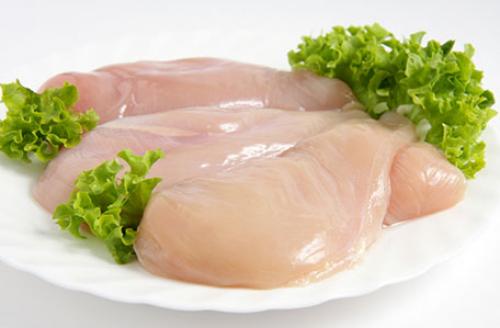
Energy value of the chicken breast product (Ratio of proteins, fats, carbohydrates):
Energy ratio (b|w|y): 84%|15%|1%)
Chicken breast is a universal dietary product that combines several significant benefits. Due to its minimal fat content and low calorie content, which is based on protein, it is included in most modern diets. It can be easily found in any grocery store or market; the cost of chicken breast is much lower than its analogues, such as turkey. Its only drawback is that the meat is a bit dry if you cook it using conventional cooking methods (frying, boiling or baking).
Calorie content of chicken fillet for different cooking methods:
- The calorie content of boneless chicken breast (fillet) per 100 grams is 113 kcalories, with bones this figure will naturally increase to 137 kcalories.
- The energy value of breast with skin is 164 kcalories per 100 grams of product.
- The calorie content of boiled chicken breast is 95 kcalories per 100 grams of product, the rest of the calories remain in the broth.
- The calorie content of smoked chicken breast per 100 grams is 119 kcalories, but do not forget that in the manufacture of such a product preservatives and other impurities are added that are bad for health.
- The calorie content of fried chicken fillet per 100 grams of product is almost 197 kcalories, which is obvious, since butter is a high-calorie product and I do not recommend eating such a breast for people losing weight.
Chicken breast contains 23 g. protein, only about 2 grams. fat and 0.4 gr. carbohydrates per 100 g. product. This makes it easy to balance your diet, whether when gaining muscle mass or on a diet aimed at burning fat. After all, we can only get protein from chicken, and carbohydrates in the right quantities will come from more preferable foods, such as cereals and vegetables. And that is not all.
Chicken breast composition
Chicken breast is a wonderful source of vitamins and minerals. Their importance lies in the fact that vitamins are involved in all processes occurring in the human body. Vitamins act as a catalyst for processes such as protein synthesis and many others. That is, without the required amount of micro and macroelements entering the body, we will not be able to effectively lose weight or build muscle mass. In addition, vitamins support human immunity, which is important during intense physical activity.
Chicken breast contains almost all B vitamins, vitamins A, C, PP. And it contains choline - it ensures the normal functioning of the kidneys and adrenal glands, and also helps cleanse the liver of fats. It also contains a large amount of potassium, which regulates blood pressure and acts as electrolytes, facilitating the transmission of nerve impulses. Chicken breast is also rich in macro- and microelements such as magnesium, sodium, iron, sulfur, phosphorus, chlorine and other elements important for full human life.
Chemical composition of chicken fillet
The table shows the nutritional content (calories, proteins, fats, carbohydrates, vitamins and minerals) per 100 grams of product.
Chicken breast (fillet) contains vitamins and minerals: vitamin B3 - 16%, vitamin B6 - 25%, vitamin B12 - 20%, vitamin H - 20%, vitamin PP - 53.6%, choline - 15.2 %, magnesium - 21.5%, phosphorus - 21.4%, sulfur - 18.6%, zinc - 17.1%, chromium - 18%, cobalt - 120%.
, where % is the percentage of satisfaction of the daily norm per 100 g.

Nutrient balance of chicken fillet
How to properly cook chicken breast
To prepare delicious boiled chicken fillet, in addition to the meat itself, you can use:
- one medium sized carrot
- one onion (medium or large size),
- Bay leaf,
- celery stalk,
- salt and pepper to taste.
First, rinse the breast and remove the skin. It is better to choose domestic young chicken, since it is from such a bird that both the meat and the broth will be much more aromatic and tastier.
Pour water into the pan. The water level should be such that the fillet is slightly covered when it is lowered into it. Bring the water to a boil, then add the whole onion and carrot, cut the celery stalk into large pieces and add it to the rest of the ingredients. Also add about 8 peppercorns and add salt to taste. Reduce heat to low and let vegetables simmer slightly.
After about 10 minutes, you can place the chicken fillet into the pan, after setting the heat to maximum. When the broth boils, add bay leaf to it.
Cook the ingredients in the pan for 15 minutes, then cover the pan with a lid and let the broth brew for at least 10 minutes.
Remove the meat and cut it into pieces. The broth can be poured into wide mugs, add finely chopped herbs and serve with chicken fillet.
An excellent side dish for meat would be boiled, baked or fresh vegetables, as well as rice dishes.
Whole cooked chicken breast is best cut into slices and added with a vegetable side dish, served with porridge or made into a sandwich. Boiled chicken breast, cut or torn by hand into smaller pieces, is often used in salads and appetizers, where sauces and gravies provide rich flavor. It is tastier and healthier immediately after cooking, but if necessary, boiled chicken fillet can be stored in the refrigerator for two to three days, after which it will be less juicy, but still suitable for use.
Some housewives prefer not to cook, but to bake chicken breast in foil or heat-resistant dishes. A baked chicken breast actually retains more flavor, but it is not always softer than a boiled one, especially if you cook the chicken breast correctly. Therefore, you have at your disposal different ways to successfully cook chicken breast for yourself and your loved ones.
Recipes for delicious dietary and healthy dishes
Application
Chicken is prepared in a variety of ways. You can make dietary soups or hearty pilaf from boiled fillet. However, in order for the dish to be tasty, the chicken must be young and, if possible, not frozen. The fact is that the fibers in chicken have a very delicate structure, and when frozen they lose their integrity. Such meat will be too soft and will lose its taste. Boiled chicken fillet can be prepared very quickly. But in order for the dish to be not only healthy, but also tasty, you should add spices to the water, as well as vegetables - carrots and onions. Let the water boil, leave to simmer for 10-15 minutes, and only then add the meat. It can be a whole piece, or it can be cut into pieces. This method will allow you to prepare tender and juicy boiled chicken fillet.
Market Analytics
- Black Lives Matter movement: reaction and consequences for the beauty industry
- COVID-19 is changing the rules of the game in the cosmetics market
- Beauty of the future: cosmetic innovations 2021
Convenient search for beauty salons on our website
Beauty salons in Moscow Beauty salons in St. Petersburg Beauty salons in Ekaterinburg Beauty salons in Novosibirsk
Latest blog posts on our website
- Naturecream / Tremella Extract - Snow Mushroom Detox for Skin
- Prostye-sovety / How to visually enlarge your lips with makeup
- Naturecream / Apricot kernel oil for face
- Naturecream / MATRIXYL3000 - the best skin elasticity stimulator
- Naturecream / SPF in Natural Oils
- Naturecream / Geranium (Pelargonium) oil for skin health and beauty
- Prostye-sovety / Save on a beauty salon: procedures that can be done at home
- Naturecream / Growth Factor - brings back youth?
- Oksana-Lezina / 3 effective abdominal exercises from a fitness instructor for beginners
- Prostye-sovety / Making perfect curls at home
Latest forum topics on our website
- Natalya / How to properly make a gelatin mask?
- Mrs._Smith / Badly sunburned! What to do?((
- Ice / Is it necessary to combine fitness classes with a diet?
- Antonova / What can be used for hair loss?
- Radio operatorKat / Who was on a protein diet?
Other articles in this section
| Beef udder Beef udder is the mammary gland of a cow. Udder is not a product that can be called everyday, but its taste and beneficial properties are in no way inferior to other meat products. The udder arrives on supermarket shelves already in a processed state - without the taste of milk and excess fat. This is the form in which it can be prepared. Everyone remembers the taste of udder differently, mostly comparing it to chicken fillet. |
| Goose The goose is considered one of the first species of waterfowl that people were able to domesticate. The first mention of these birds was before our era. Since then, their variety has only grown and there are about two hundred of them in the world. The goose is a bird that can move both on land and on water, so it has an impressive layer of fat. This allows him to feel great in water and withstand extreme cold. The meat of this bird is dark in color, has high fat content and is quite tough. But this does not prevent it from being in demand, although less than chicken meat. To taste softer meat, you should choose a young specimen. |
| Veal Leg The leg is the meat located around the thigh portion of the calf's leg. In the classical presentation, the ham is usually divided into two types: back and front. By separating the meat from the bone, we get two full pieces: the inner and outer parts of the thigh, respectively. Each of them has its own unique culinary characteristics, according to which they are chosen for preparing a particular dish. |
| Minced lamb Minced lamb is a healthy product from which a variety of meat dishes of many nationalities are prepared. Dishes made from such minced meat are popular in European, Asian, Mediterranean and Caucasian cuisines. Minced meat from young lamb is the most valuable; it is also brighter in color than minced meat from old lamb. |
| Beef brisket Beef brisket is meat that comes from the front part of a fresh beef carcass. There are several varieties of recipes for preparing this product, but now we will talk about smoked brisket. |
| Smoked chicken As everyone knows, chicken meat is considered a dietary product. This is especially true for boiled and smoked cooking methods. People have been smoking this bird since ancient times, and every smoked dish turns out very tasty and juicy. There are two types of smoking: hot and cold. The former is much faster and the product is softer. The second method is longer - it requires several days. |
| Roasted turkey Turkey meat is a product containing a number of nutrients and beneficial substances. Its benefits for the body have long been proven - it is an indispensable dietary product. Many developed countries are actively breeding turkeys for further sale. Turkey already arrives on store shelves, usually in a dressed state. A whole carcass can rarely be bought in a supermarket, only at farmers' markets. It is customary to bake a whole turkey with apples in the oven. But fried turkey is also considered very tasty. |
| Beef entrecote Entrecote is the general name for meat dishes made from intercostal flesh fried in oil. It originates from classical French cuisine, as evidenced by the name itself (French “entre” - between and “côte” - rib), and the method of its preparation. A synonym for entrecote in cooking can be called a chop cutlet - a beaten and fried piece of meat on the bone. Nowadays, to prepare entrecotes, they take not only pieces from the intercostal space. Under this name, prepared semi-finished products made from boneless beef or pork, about 1.5 cm thick, are often found. As a source of nutrition, beef ranks first in popularity among meat products. It appeared in the regular diet about 8 thousand years ago as a result of the domestication of wild bull by Balkan tribes. The best commercial beef is obtained from castrated young bulls no older than 2 years. |
| Rabbit Rabbit meat is a dietary by-product and a valuable type of white meat. It is widely popular in Russian cuisine, but it is not often seen on the everyday table due to the high cost of the product. Rabbit meat is rich in valuable proteins and minerals and contains virtually no fat. Recommended by all doctors and nutritionists, as it has virtually no contraindications. |
| Stewed horse meat Horse meat is a high-calorie, healthy and nutritious meat. It is an expensive delicacy, and appears on supermarket shelves mainly in the form of sausages and stews. Stewed horse meat retains all its properties after processing or canning, and is a dietary meat. |
Chicken breast with and without salt
The healthiest chicken meat is boiled. It is in this way that cooked chicken breast is a leader in dietary nutrition. Based on it, you can prepare a lot of not only healthy and tasty, but also low-calorie dishes:
- salads;
- stew;
- pates;
- soups.
Whether you salt the chicken meat during cooking or not, this will not affect the calorie content of the finished product. Salt should be excluded only if you adhere to a strict diet for some period of time.
Oatmeal in dietary nutrition
Diets with chicken breast
Thanks to its balanced composition, chicken breast is an excellent diet product. So experts in the field of weight loss have developed several types of diets based on chicken breast. The first of them is seven days. For it you need to boil 800 g of chicken meat in 2 liters of water. In order to preserve the taste of the product, you can add celery root, carrots and onions to the pan to taste. Then divide the boiled chicken meat into 5-6 equal portions in proportion to meals per day. The main feature of the diet is the non-use of salt when preparing dishes. It is also prohibited to add soy sauce to enhance the taste. You can use lemon juice to add some piquancy. The disadvantage of this diet is that it cannot be used for people with kidney, liver, heart and stomach diseases. In addition, it is also contraindicated for pregnant women.
There is a second diet option using chicken meat. It is designed for the same 6-7 days. In the first three days, you are allowed to eat only apples (1.5-2 kg per day in equal shares). Then 1 day - 1 kg of chicken breast, the next 2 days - 2 liters of kefir (1%) per day. Last day - chicken broth, prepared without salt.
On average, following one of the diets you can lose from 1.5 to 3 kg, which is not a bad result. Plus, chicken breasts are so nutritious that you won't feel hungry.
All about the cottage cheese diet
Is it possible to lose weight by eating chicken?
The peculiarities of the composition of chicken fillet allow you not only to lose weight without experiencing a constant feeling of hunger, but also to improve your body’s health.
The diet, which is based on eating chicken fillet, is aimed at burning fat, and not at removing excess fluid. This feature allows you to reduce weight up to 5 kg per week and maintain the result for a long time. The duration of the diet should not exceed 7 days. At this time, salt and sugar are excluded from the diet. Drinks allowed are still water, green and herbal tea.
Do you want to lose weight? Then these articles are for you
We train at home.
Chair workout Lose 5 kilograms in 3 weeks.
Why am I not losing weight?
During the diet, chicken fillet can be consumed either boiled or baked. The skin must be removed before cooking. Chicken meat can be supplemented with fresh or stewed vegetables and side dishes of cereals. Fruit salads are allowed.

Tips for using chicken breast in your diet
It is recommended to store boiled breast in the refrigerator for no more than 36 hours, placing it in an airtight container. If necessary, the finished fillet can be frozen. Frozen product can be stored for no more than two months.
White chicken meat goes perfectly with leafy greens, which contain a lot of fiber, including spinach (calorie content 20 kcal per 100 g of product). Chicken breasts are served with green beans (24-32 kcal per 100 g of product), fresh vegetables, eggplant, kohlrabi, rice, buckwheat, unsweetened fruit, and dry white wine. Lean boiled breast is the basis of a variety of dietary salads.
Lean white meat is perfectly tolerated by the human body, is easily digestible and rarely causes allergies. The essence of the protein diet is that with an excess of proteins, the body begins to experience a lack of carbohydrates, which forces it to use up its own energy reserves. First, excess water is removed, which allows the muscles to tighten. Then the process of protein synthesis into glucose occurs in muscle tissue. And finally the breakdown of fats begins.
Chicken breasts are an affordable and inexpensive product. A diet using white chicken meat allows you to lose extra pounds without feeling hungry, while maintaining performance and good physical shape.
